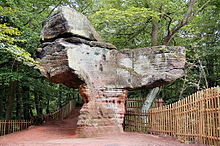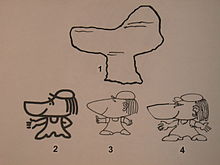Boots (rock)
The boot is a red sandstone rock with a peculiar shape , created by weathering . It is located in the district of the city of St. Ingbert , near Sengscheid in the Saar- Palatinate district in Saarland and is considered a landmark of the city.
Geographical location
The boot is located on the north-eastern slope of the wooded mountain ridge "Großer Stiefel" ( 397.2 m above sea level ) at about 350 m above sea level between the districts of Rentrisch and Sengscheid . NN . The hiking trails are best reached from the boot car park in Sengscheid. The federal motorway 6 with the nearby junction St. Ingbert-West on the state road 126 connecting the two parts of the city leads east past the mountains and rocks.
Appearance and shape
The lower part of the rock is weathered all around to form a low column measuring about 6 meters in circumference and carries the entire upper stone mass. This is in turn overlaid by a massive block so that the whole thing looks like a shoe or boot. The interpretation that the shape resembles an upturned boot is also common.
Name origin
It is mostly assumed that the rock, which is also called Stiefler Fels, gives the whole mountain its name.
However, there are also opposing views, e.g. B. that the name comes from the boot-like shape of the mountain. The name researcher Hermann Albert Prietze, on the other hand, derives the name “Großer Stiefel” from the Thingstapel , the court column , which is also confirmed by the Stiefelberg in the Reichartshausen community , which served as a place of execution for centuries.
history

The natural monument probably served cultic purposes as early as the Neolithic Age. Stone blades, arrowheads, grinding stones and stone axes dating from the Mesolithic (8000 to 4000 BC) have been found on the ridge of the Great Boot . A cultic connection with the Spellenstein in Rentrisch, 1,300 m away as the crow flies, can be assumed, because the "boot tip" points to the Spellenstein.
In the 10th century a castle was built on the big boot, the Stiefler Schloss . Numerous remains of walls, earth walls and ditches still bear witness to this castle today.
The Stiefelhütte or Heinrich-Kohl-Hütte (named after one of the club's founders) was built in 1912 by the Palatinate Forest Association. After the original hut burned down in 1983, the association built today's hut immediately afterwards. The PWV also erected a memorial stone on the boot plateau in 1960, it serves as a memorial stone to commemorate the victims of the two world wars.
Advertising medium
The “boot” served as a template for the creation of a figure named “Ingo”, who advertises St. Ingbert as a popular figure. The Saarbrücken graphic artist Karl Basters (1948–2008) designed the figure with the outlines of the boot and a lion's head, which is intended to commemorate St. Ingbert's membership of the Kingdom of Bavaria for almost 104 years . In addition to the standard Ingo, Basters created more than 50 variants of the "Ingo" over the course of several years, such as the "Wander-Ingo", the "Sport-Ingo" or the "Polizei-Ingo". "Ingo" was primarily issued as a sticker, but there were also a number of three-dimensional variants made of different materials.
Others
In a survey by the Heinz Sielmann Foundation EUROPARC Deutschland eV, the boot was voted Germany's third most beautiful natural wonder of 2013. There were 21 natural monuments to choose from from the national natural landscapes and other regions of Germany. The Rauhe Kulm near Neustadt am Kulm took first place . The Stone Rose near Saalburg-Ebersdorf followed in second place .
literature
- Thomas Strauch: Stone witnesses of 4,000 years of cultural history - A look at important natural and cultural monuments of the Saarland . Yearbook for the miners' calendar 2006, pp. 147–153, publisher: Deutsche Steinkohle AG.
- Bernhard Becker (Ed.): "… Die Mutter Erde schmüket", gardens, parks and natural monuments in the Saarpfalz , Verlag Gollenstein, 2010, ISBN 978-3-938823-50-7
- Wolfgang Krämer: History of the City of St. Ingbert - From the Beginnings to the End of the Second World War - A local history based on archival sources , Second, completely revised and significantly expanded edition in two volumes, City of St. Ingbert self-published, St. Ingbert 1955. And: Reprint of the 2nd edition in one volume, St. Ingbert 1989
- Ernst Probst: The Urnfield Culture: A culture of the Bronze Age before about 1300/1200 to 800 BC. Chr , Norderstedt, 1996, ISBN 978-3-640-11173-2
- Hermann Albert Prietze: The secret of the German place names , Hannover-Linden, 1929
Web links
- Literature on the boot (rock) in the Saarland bibliography .
- The Boot Rock at St. Ingbert. Article by Rembert Schmidt, on the website of the Palatinate Forest Association, St. Ingbert local group, version 4 from May 28, 2003
- Large boot picture gallery Maps and photos of the boot and the large boot on a private website on Saar archeology
Individual evidence
- ↑ a b A foray into St. Ingbert's history ( Memento of the original from October 10, 2011 in the Internet Archive ) Info: The archive link has been inserted automatically and has not yet been checked. Please check the original and archive link according to the instructions and then remove this notice. Article on the website of the city of St. Ingbert, accessed February 1, 2011
- ↑ Map services of the Federal Agency for Nature Conservation ( information )
- ↑ a b Rembert Schmidt 2003, see web links
- ↑ a b Wolfgang Krämer 1955, Volume 1, Page 4
- ↑ The Boot at St. Ingbert ( Memento of the original from June 9, 2010 in the Internet Archive ) Info: The archive link was automatically inserted and not yet checked. Please check the original and archive link according to the instructions and then remove this notice. Article on the website of the district administration of the Saarpfalz district, accessed on January 29, 2011
- ↑ Big Boot, Unique rock formation created by nature ( Memento of the original from August 11, 2014 in the Internet Archive ) Info: The archive link has been inserted automatically and has not yet been checked. Please check the original and archive link according to the instructions and then remove this notice. Description on the website of the Saarland Tourist Board
- ↑ Large boot picture gallery Maps and photos of the boot and the large boot on a private website on Saar archeology, accessed on February 8, 2011
- ↑ A foray through the history of Sankt Ingbert Article on the website of the Paritätisches Bildungswerk, Landesverband Rheinland-Pfalz / Saarland e. V., accessed February 8, 2011
- ↑ Ernst Probst 1996, page 22
- ^ Hermann Albert Prietze 1929, page 207
- ↑ History of the Reichartshausen community ( Memento of the original from May 15, 2010 in the Internet Archive ) Info: The archive link was inserted automatically and has not yet been checked. Please check the original and archive link according to the instructions and then remove this notice. Article on the website of the Reichartshausen community, accessed on February 8, 2011
- ↑ Bernhard Becker, 2010
- ↑ The Stiefelhuette awaits its birthday guests , Saarbrücker Zeitung, accessed on September 8, 2019
- ↑ Testimonials from the past Article on a private website about circular hiking trails in Saarland
- ^ Heinz Sielmann Foundation: Natural wonder of the year 2013
Coordinates: 49 ° 15 '31.19 " N , 7 ° 5' 42.03" O


